#Landmark books
Explore tagged Tumblr posts
Link
Added to the Vintage shop!
~ “The Mississippi Bubble” by Thomas B. Costain (1955) Landmark Books
#The Mississippi Bubble#Thomas B Costain#Thomas Costain#Landmark books#vintage books#Vintage children's books#VintageCDChyld#Vintage#Etsy
0 notes
Text

Belém Tower, Lisbon, Portugal. Fair Lusitania. 1874. Cover detail.
Internet Archive
#castle#covers#book cover#gold gilt#medieval#architecture#nemfrog#1874#19th century#belem tower#lisbon#landmarks#portugal
712 notes
·
View notes
Text
Landmark books and Cornerstones of Freedom books were really standard and highly regarded for kids in the circles I grew up in.
Was it just me who grew up on tales of the Flying Tigers and the Lafayette Escadrille? The romance, the glory of being in the vanguard of American involvement in what became a world war? Like, it doesn't surprise me in the slightest that there are Americans eager to fight for Ukraine! I was practically taught how to read on these stories.
#Lafayette escadrille#landmark books#flying tigers#Cornerstones of Freedom#foreign legion#ukraine invasion
21 notes
·
View notes
Text
feeling a spark of immense rage rn


#rwrb#rwrb movie#red white and royal blue#red white and royal movie#red white and royal blue book#Prince consort road#alex claremont diaz#henry fox mountchristen windsor#casey mcquiston#landmarks#London#taylor zakhar perez#nicholas galitzine
82 notes
·
View notes
Text

Headless Horseman is a analogy on history:
no matter what he will never die and will always continue to haunt those still alive!
🐴🎃
#history#headless horseman#horror#sleepy hollow#the sketch book of geoffrey crayon gent.#american history#washington irving#battle of white plains#halloween season#historical figures#horror history#halloween#dutch reformed church#classic novels#american revolution#writing history#1800s#landmarks#disney#travel girl#assassins creed rogue#hessian#spooky season#united states#new york#nickys facts
10 notes
·
View notes
Text
Thistle Law
The most extreme, violent interpretation of the Warrior Code, initially founded by Thistleclaw near the end of the Campaign Era, with its first implementation defining the beginning of the Slash-and-Burn Period.
One of three distinct Clan ideologies, next to Fire Alone and Traditionalism.
A guide to its origin, the parable associated with it, its principles, and most importantly, my authorial intentions with it in the Bonefall Rewrite. Seen a couple of questions about it, so I think this’ll help clarify.
Origin
Extreme interpretations of the Code go back as far as the founding of the clans themselves, but the roots of Thistle Law trace back to the Exile of SkyClan. Justifying the loss of an entire clan included cracking down on medicine cats and quashing a rebellion, and the ‘clan pride tide‘ added FOUR new laws to the Warrior Code.
The following wars and conflicts in the Chivalric Period further contributed to xenophobic sentiment in the Clans, with each one vying for supremacy over the others, branching out to attack non-Clan cats when there were brief stints of ‘peace’. Thistleclaw merely gave these ideas a name while educating his apprentice, using thistles as a metaphor.
Tigerclaw then went on to tell the story to his clanmates, to his own apprentices, and at gatherings to his future allies who told it to their own clanmates. Though the details of the story changed at times, the takeaway is constant;
Other cats must die, so yours can stay strong.
The Parable of the Thistle
The story goes that Thistleclaw brought Tigerpaw out to a massive, thorny bull thistle. He pointed out that the other plants were dying around it, but the flowers stood tall and proud. Thistleclaw explained the thistle was killing the plants around it to have more room to grow, and then cruelly commanded that Tigerpaw try to destroy it.
By the time it was done, Tigerpaw was covered in scratches and the sun was setting. All the way home, he tried to shake the thistlefluff out of his fur and forget the painful experience. The seasons turned, and one year later when Tigerclaw was a young warrior, Thistleclaw led him down a path lined with young, thorny leaves.
There, in a sea of green spikes, the thistle was standing as tall and as proud as the day Tigerpaw shredded it.
In killing every other plant in the area, the thistle had given itself room to come back stronger. The fluff that clung to Tigerpaw’s fur became new growth. Around them was an entire clearing of thistles, ready to burst into a wall of flowers and seeds.
Thistleclaw asked if Tigerclaw would dare to try again, and remembering how his last battle with the weed ended with scratches as deep as claw marks, admitted that he would rather be a thistle than fight one.
(Little did Ivypaw know, the beautiful field in which she meets Hawkfrost was completely strangled by flowering thistles.)
Principles
Depending on the exact time period and the cat it takes root in, Thistle Law can look different. For examples, Brokenstar’s goal was to drive every Clan out of the forest except ShadowClan, where Tigerstar’s aim was to annex every clan into TigerClan and enforce a standard of purity.
Incarnations of Thistle Law tend to share these principles,
The Code Hardens The calling card of Thistle Law is a stricter, more violent interpretation of the Warrior Code. The harsher laws are emphasized, such as the Law of Loyalty and the Right of the Challenge, while softer ones are downplayed or dropped entirely, like the Law of Honor and the Queen’s Rights.
Extreme Xenophobia Against outsiders, against cats of other clans, against half-clan cats. Thistle Law sets itself apart from Traditionalism for becoming willing to enforce some sort of purity.
Hierarchy Becomes Rigid The social power of medicine cats, deputies, and elders is suppressed. The leader is raised as the ultimate authority, even if that leader isn’t the Clan’s -star.
There Is No ‘Pointless’ Death The Clans are a battle culture, but a good battle is still fought for a reason. When tides turn to Thistle Law, fighting is the goal AND the means. To live is to battle, to kill is to win, and a warrior’s purpose is to die at war.
Each incarnation likely contains each point in varied amounts and tosses other ideas into the mix, but the name of the game remains the same-- and it springs from the taproot of Thistle Law.
Intentions
Thistle Law is what fascism looks like in Clan culture. I approach this using Umberto Eco’s 1995 essay Ur-Fascism as my primary reference. Ur-fascism is a ‘fuzzy‘ concept that looks very different depending on the exact society it springs from, mixing and matching several symptoms in varying degrees of severity.
So, in adapting this, I had to simplify a very complicated topic. I wanted to keep the antifascist theory recognizable, while still following canon events and creating an engaging rewrite.
So for simplicity sake, even if a clan might have technically called their own version of Thistle Law something else, I use this name to address it.
#tw fascism#fascism#politics#Bonefall Rewrite#Thistle Law#Thistleclaw#Tigerpaw#As a side note I really gotta finish this post I have about locations in the Dark Forest#Because I actually plan to make it the inverse of StarClan territory where all the BAD landmarks end up there#Like how StarClan still has fourtrees? The DF has the bonehill#And the thistle field#And the 5th oak#And the old river but the water is always flooded#Hope this clarifies btw feel free to @me with any other questions about thistle law this doesn't make clear#I don't want to get into MORE theories on fascism though btw unless you have a specific rewrite event suggestion#I like Eco's essay because it's easy to reference#I would prefer to spend my time reading more terrible cat books and visit theory at my own pace lmao
210 notes
·
View notes
Text






























The Colorado National Monument was established on May 24, 1911.
#Great View#Fallen Rock#Independence Monument#Grand Valley#travel#Colorado Plateau#Colorado River#Book Cliffs#Balanced Rock#vacation#Colorado National Monument#established#24 May 1911#anniversary#USA#US history#Coke Ovens#tourist attraction#landmark#original photography#desert#rock formation#Mesa County#landscape#countryside#nature#blue sky#clouds#summer 2021
19 notes
·
View notes
Text





This is the year of @avasdemon and @tinypaint !! The 2nd book's kickstarter rewards are finally here and Ava's Demon had its storewide release back in May. I am so proud of what you've accomplished and amazed by the quality of how everything came out. We're all very proud of what you've accomplished!
#lspicerart#original art#ava's demon#yeahhhhh kickstarter rewards baby!#I wish I could've afforded more but I am still very happy I was able to have the kickstarter version of the books on my shelf#it's party time to celebrate Michelle's landmark achievement!#avas demon
26 notes
·
View notes
Text
Very on brand of me to enter the UK, go directly to Hay-on-Wye, and immediately purchase a Robert Macfarlane book. No one should've expected anything else, honestly.
#listen i heard book town and I went 'say less'#and then walked into a shop and found a book i didn't have! so like. only wins today.#(i almost brought landmarks and didn't cuz i opted to bring a book i hadn't read)#the one i got is The Old Ways
24 notes
·
View notes
Text
Turns out working in a queer history archive means learning a lot about the personal quirks of local Queer Elders of national historical significance
#thank you for printing out. the wikipedia page. for the author of the autographed ya book you donated to us and sticking it inside sir#i'm going to think about this every time i hear about your landmark marriage equality milestone now (affectionate)#nate at the museum
38 notes
·
View notes
Note
all non participating countries have their flags banned at eurovision
I'm well aware. I wrote that in the translation.

#Sorry if this comes across as rude I do not mean it to be#I just wanted to actually check that I wrote it in and then took a screenshot so that you wouldn't have to look for the post again#I am still allowed to be unhappy about this tho#Yes I am aware that they are not participating#but I believe that people who are going to Eurovision should still be allowed to show their support#What is happening in Palestine right now is horrible and people should be allowed to show their support for the people#And Eurovision would be a good place to show it#It is a big thing and people from all over the world watch it#If the terrible happens and Israel get away with the genocide then the history books will be written from their point of view#They have been actively destroying landmarks so them trying to erase Palestine from history doesn't seem farfetched to me#Having people show support for Palestine in Eurovision would work against that#Because people in the future will look back at Eurovision from this year and would see the flag#I am probably overreacting but I wanted to get my feelings out#Eurovision#Palestine
5 notes
·
View notes
Text

Accompanied by some really beautiful artwork, Britain's Landmarks and Legends is a fantastic read about the legends and folklore that follows and shrouds some of Britain's historic places.
Discovering some incredible new places that are filled with history and legend, this book shines a light on places I've never heard of, even in my home county and across the UK where we discover rings of stones, castles of lore and places of natural brilliance.
A real joy to take in, this book will make you want to get up and go outside and see something new.
(I received an ARC from Netgalley for review).
9 notes
·
View notes
Note
Munakata and Fushimi on a long train ride together in their own private car. What do they talk about? Reisaru would be lovely, thank you!
I bet Munakata would enjoy a nice private train ride, maybe they have to go somewhere for a work mission and Munakata thinks this would be better than flying. There’s like some conference at a resort up in the mountains and Munakata asks Fushimi to accompany him (not at all so they can relax together and have a small vacation). Fushimi complains about all the work that won’t get done but he agrees to go, he’s surprised when Munakata has them driven just to a train station rather than the airport or taking the vans all the way. Munakata says it’s a scenic area and he thought perhaps taking this route would be calming. Fushimi shrugs and says he doesn’t like trains, looking distastefully at the crowds around them, and Munakata assures him that he’s rented them a private car.
When they get into their private room Fushimi has to admit it isn’t that bad, at least there’s plenty of room and no one around to bother them. Munakata says they have a long ride and Fushimi should settle in. As he’s speaking Munakata pulls out a puzzle from his luggage and starts laying out all the pieces in a pile on the floor, Fushimi looks all disbelieving like you’re really going to do a puzzle on this trip Captain. Munakata says he was hoping to find something to pass the time, Fushimi rolls his eyes like most people bring a book you know. Munakata chuckles all ‘is that so’ and focuses on his puzzle.
Fushimi tries to play on his PDA but he’s distracted by Munakata there on the floor carefully putting the puzzle together. Finally he can’t hold it in and Fushimi asks what Munakata’s making this time. Munakata says it is a special puzzle he has commissioned, of S4 headquarters. Fushimi leans his chin on his hands as he says no picture then, since Captain has the building layout memorized. Munakata laughs and says correct, Fushimi rolls his eyes and quietly mutters that at least it isn’t his face this time. Munakata asks if Fushimi wants to join him, Fushimi says wasn’t Munakata the one talking about the view, he’s not going to see any of it if he’s doing his puzzle the whole time. Munakata wonders if Fushimi’s worried about him missing the sights and Fushimi denies it, leaning back and looking out the window himself.
The seat dips momentarily as Munakata sits down beside him and Fushimi looks over, wondering about the puzzle. Munakata says Fushimi was correct, it wouldn’t do to ignore the view for the entire trip, and the puzzle can wait. Fushimi mutters that he didn’t mean Munakata had to come over here now and Munakata wonders if Fushimi is bothered by his presence, Fushimi denies it. As they get deeper into the mountains Munakata starts pointing out various landmarks and explaining the history behind the area, Fushimi acts like he’s not listening but he’ll occasionally ask a question and Munakata just beams as he answers. Eventually I imagine Fushimi dozing off against Munakata and Munakata leans back to stroke his hair, thinking that it seems he won’t finish his puzzle on this trip after all but he doesn’t really mind that at all.
#Reisaru#Talking K#Munakata will get to his puzzle on the way home :)#some people bring books he brings puzzles#but then he gets to see the sights with Fushimi-kun#I imagine if there are lots of landmarks he points them out#or explaining local history
14 notes
·
View notes
Photo
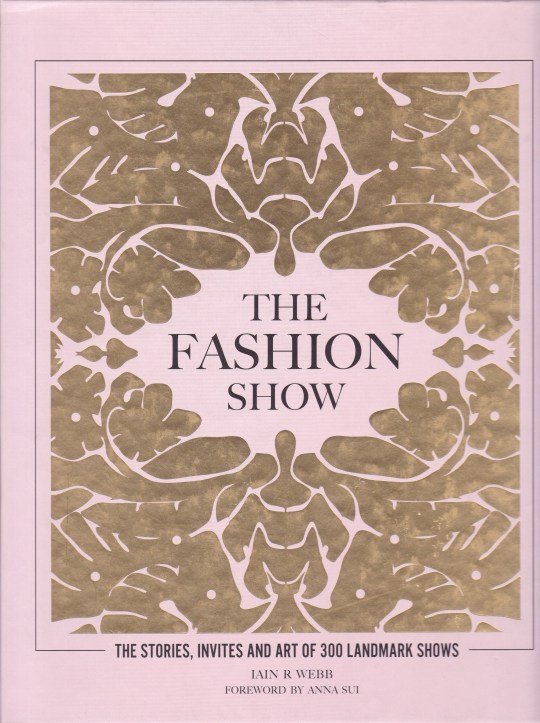

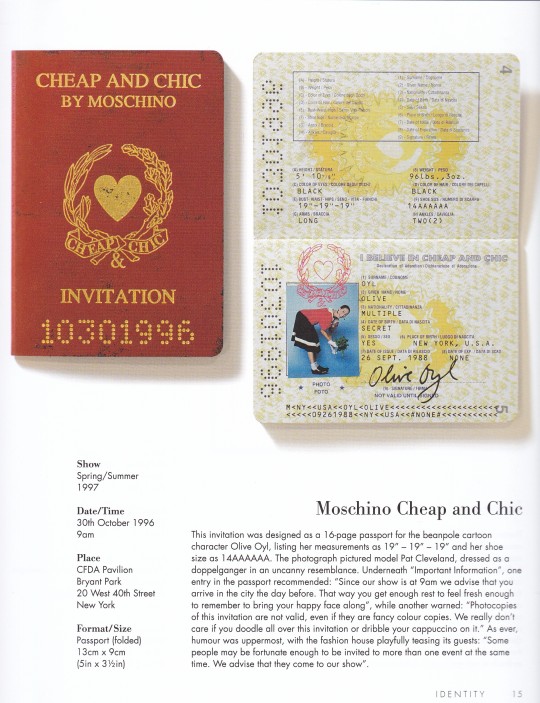
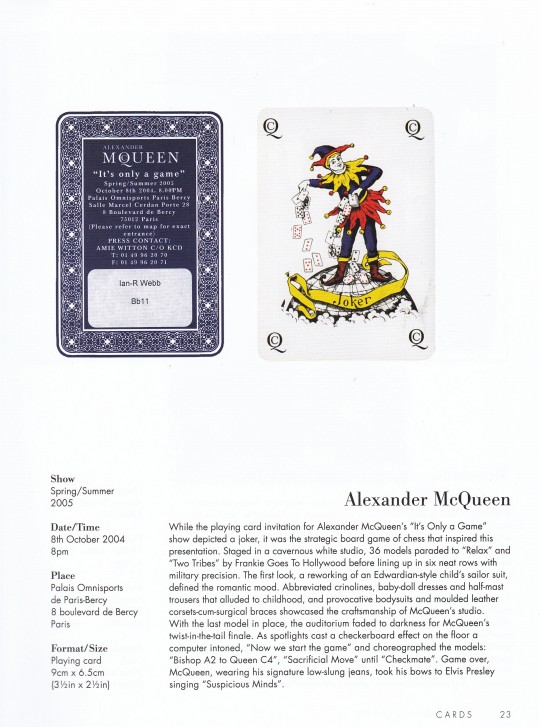
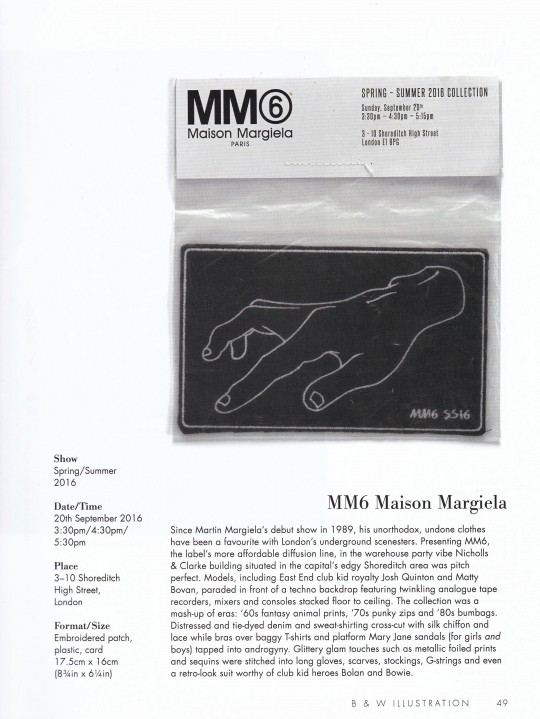

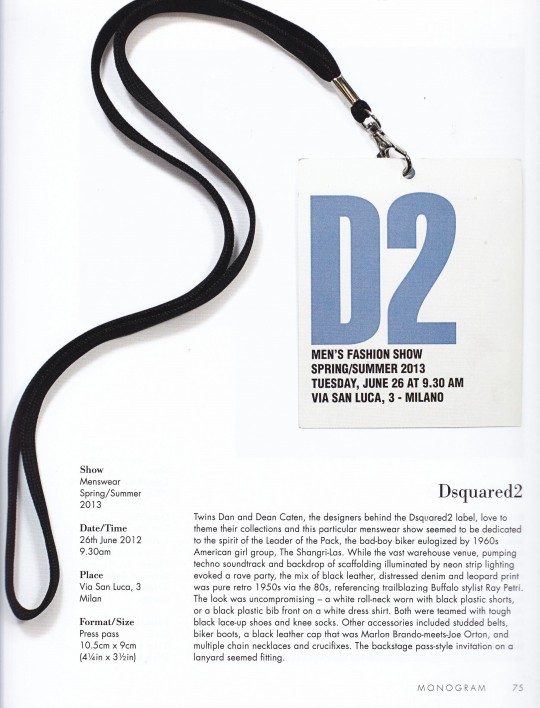
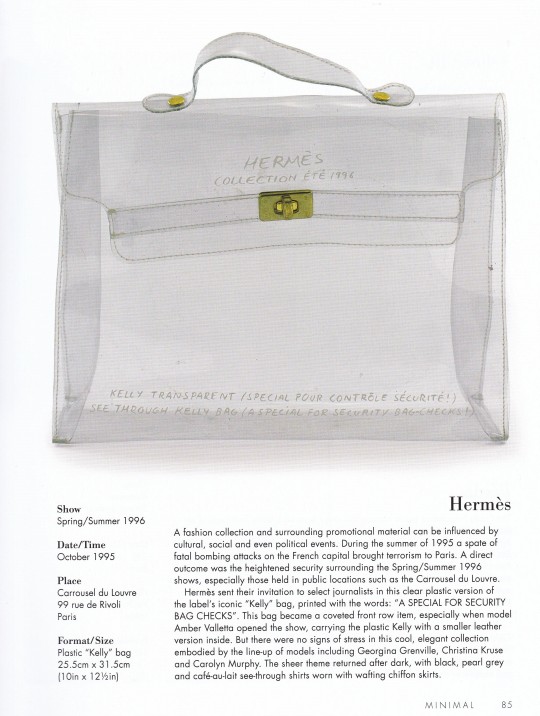
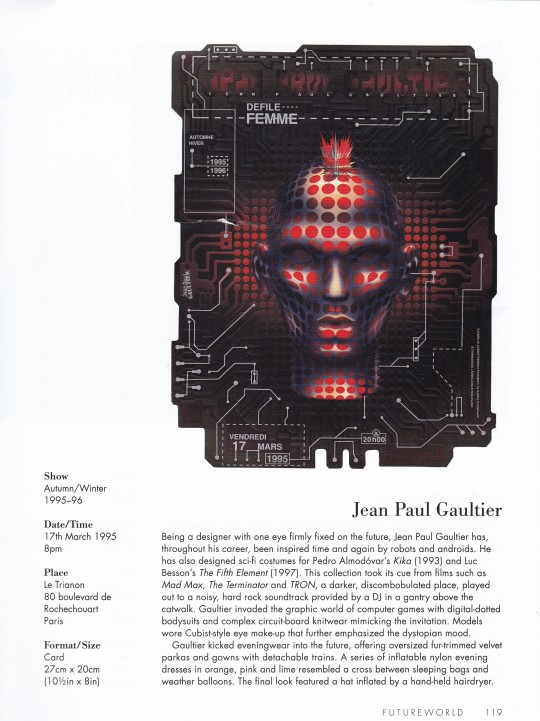

The Fashion Show
The stories, Invites and Art of 300 Landmark Shows
Ian R.Webb Foreword by Anna Sui
euro 42,00
Welbeck Publ.Group, London 2022, 320 pages, 29.21 x 25.4 cm, ISBN 978-1802790832
euro 42,00
email if you want to buy :[email protected]
First published as Invitation Strictly Personal in 2014
This is your invitation to the front row. Spanning over seven decades and 300 shows, this beautiful book tells the story of the high fashion catwalk. Through this inspirational collection of fashion show invites and tales from fashion week, curator and fashion writer Iain R Webb opens a window into the world’s most exclusive fashion houses. Whether it’s dreamy romance at Givenchy, cutting-edge modernity at Alexander McQueen, floral drama at Valentino, vintage-inspired fun at Kenzo or heartfelt emotion at Yves Saint Laurent’s final haute couture show, the unique themes and styles that have graced the runway in the past 50 years are gloriously curated and described in The Fashion Show. From understated presentation to melodramatic performance, this stylish archive is your passport to the international fashion collections.
20/01/23
orders to: [email protected]
ordini a: [email protected]
twitter: @fashionbooksmi
instagram: fashionbooksmilano, designbooksmilano tumblr: fashionbooksmilano, designbooksmilano
#The Fashion Show#shows invites#high fashion catwalk#Givenchy#Alezander McQueen#Valentino#Kenzo#Yves Saint Laurent#Gaultier#Hermès#Anna Sui#Dsquared2#Maison Margiela#Moschino#Ossie Clarck#landmark shows#fashion books#fashionbooksmilano
27 notes
·
View notes
Text
while I want to stretch out my comic ‘roadtrip’ and add and explore lots of little scenes I’m going to have to cut it short and work on making roadtrip pause at a satisfying point. thinking of fruity four finding some money, getting some food and a motel for the night. At some point I have to direct my time and energy into my real life lmao and make illustrations that could get me a job/make me look professional lmao :/
#gmaybe666#I wish I could treat like it whole ass comic book#I want to explore both jargyle and byler moments. have them go camping in the desert. stargazing. see ufo landmarks. be repressed gay#😭
6 notes
·
View notes
Text
Let's rewind 73 years and 3499 issues back to Topolino #1
Times were dire in 1949. Italy had just exited II World War in... erm... not the best shape 🙄. Italian currency, the lira, had fall to about a 30th of its pre-war value. People had barely the money to buy food, let alone newspapers or -god forbid!- comics.
Saving money was publishers code word. Milan based publishing house Mondadori had just resumed printing Topolino after two years of stop due to the war (they acquired it in 1935 from Nerbini), and in 1949 sales had dropped: it was time to cut the costs. What better way than to put to work some unused rotary presses?
The previous year Mondadori started publishing an italian version of the Reader's Digest (the Selezione dal Reader's Digest), which was a monthly publication, that meant the rotary presses bought specifically to print it had a substantial idle time. Maybe they could use them to print Topolino?
Well, yes... but there comes the problem: the Selezione dal Reader's Digest had a completely different format that newspaper size Topolino.

Selezione dal Reader's Digest #8 dated May 1949
It was Arnoldo Mondadori's brilliant intuition to transform the big, inconvenient newspaper into a smaller digest size comic book with Disney stories only.
Starting from Topolino #737, Mondadori began advertising the big changes that were about to come. Changes that would affect not only the size of the publication but its frequency too: Topolino wouldn't be a weekly publication any more but a monthly one.

Inside page of Topolino (newspaper) #738 announcing the big changes!
Issue #738 was the last one in newspaper format. In April 1949 comes a totally new magazine starting over from issue #1: it's a little booklet of 100 pages, sized 12,5×17,8cm with a bright red cover dominated by a joyous Mickey Mouse dressed as a band conductor . It was the beginning of a new age.
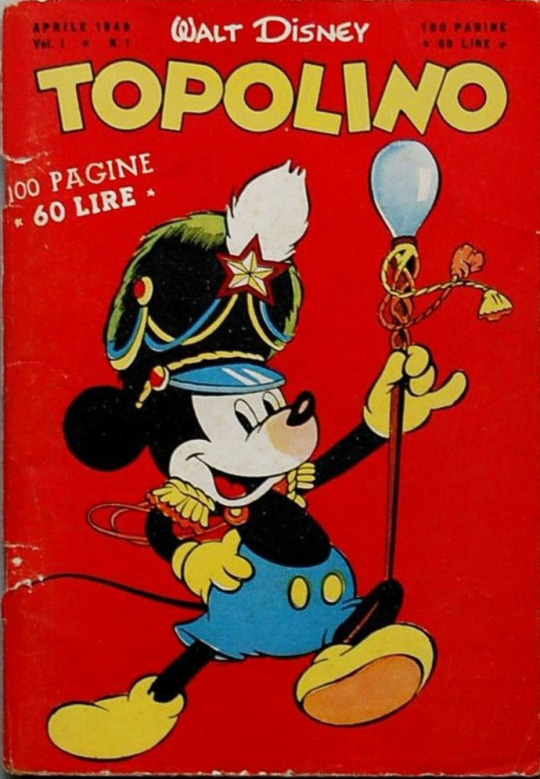
At Mondadori, though, they were not entirely convinced about the success of the operation. Such big changes tend to scare customers away, especially if you consider the price increase from 15 to 60 lire! But it was those same customers to prove them wrong (I mean, was Arnoldo Mondadori ever wrong?).
The readers loved the new Topolino. Sales increased rapidly and already in issue #8 readers could find a postcard in which the publisher asked them how would they feel about Topolino becoming a fortnightly publication? Just asking... :D
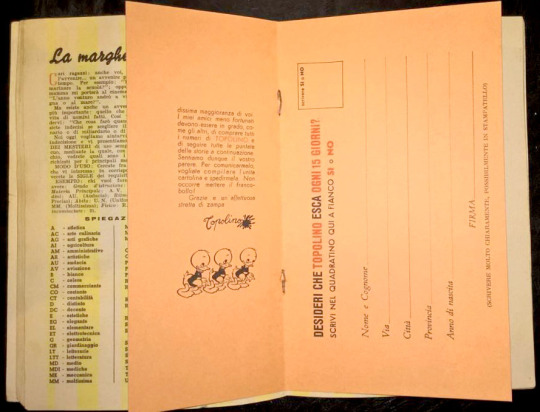
So... "Do you want Topolino to become fortnightly? Write YES or NO in the box to the right"
Topolino became fortnightly in 1952 and in 1960 it was back to be a weekly magazine. From 1961 it is fully in color and in 1967 it acquires its signature yellow spine.
Topolino #1 had a circulation of about 100.000 copies. Despite the wide diffusion a mint copy of it, nowadays, it's worth around 2000€ that's mainly because it's HIGHLY sought-after.
(Obviously a reprint of) Topolino #1 😜
The first story of Topolino #1 is actually the 27th and last chapter of Guido Martina's "Topolino e il cobra bianco". The story was previously published on Topolino newspaper from issue number 713 to 738. And this issue also marks the debut of Eega Beeva in Italy by publishing Floyd Gottfredson's story "The Man of Tomorrow".
Mondadori kept publishing Topolino up until 1988 with minimal changes and even after that the magazine basically remained untouched. The biggest difference between today's issue #3500 and 1949's #1 it's the binding, and the modern Topolino is a bit larger.
We can undoubtedly affirm that Arnoldo Mondadori is the father of Topolino as we know it today. And we must thank him if Topolino is the most long running comic book in Italy (sorry, Tex, but the years spent in newspaper format DO COUNT 😏).
Here's a list of the stories published on Topolino #1 (worth to be noted, Martina's "Topolino e il cobra bianco" is the only italian one: the italian Disney school was just at the beginning):
Topolino e il cobra bianco The Man of Tomorrow Gladstone Returns Brer Rabbit Bucky Bug as fire fighter Li'l Bad Wolf - Red Riding Hoodwinked Pluto saves the ship The Old Castle's Secret

From left to right: Arnoldo Mondadori, Topolino's editor-in-chief Mario Gentilini and Walt Disney in Milan during the Salone del Bambino book fair (September 1965). Source.
#i talk talk talk talk talk...#long post#topolino magazine#topolino history#comic books history#arnoldo mondadori editore#italian disney comics#topolino 1#topolino 3500#guido martina#landmark issue#italy
26 notes
·
View notes